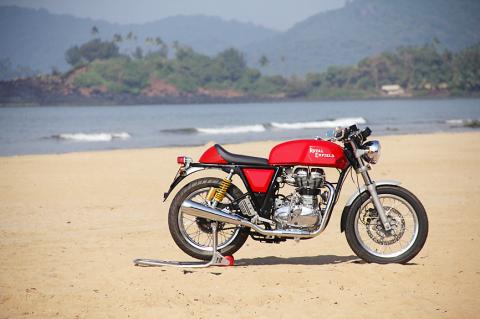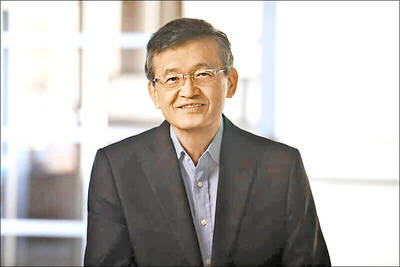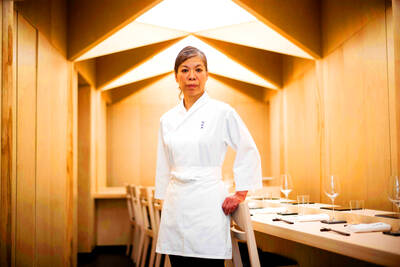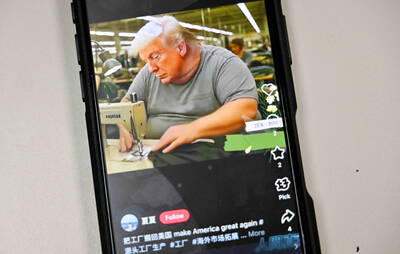Motorbike manufacturers are riding a wave of swinging ’60s nostalgia with new models seeking to capture revived interest in the classic looks of the period — with demand helped by fashionista-in-chief David Beckham.
Royal Enfield, an Indian-owned manufacturer of British heritage, is the latest to try its luck with a new bike inspired by the “cafe racers” seen around London in the late 1950s and 1960s.
These single-seater two-wheelers were some of the quickest of their day, modified and driven at the highest speeds possible by their young male riders dressed in the “rocker” fashion of the era.

Photo: AFP
After a trip in search of the mythical “ton” — 100 miles (161km) per hour — they would retire to the Ace Cafe in northwest London for cups of tea, making it a famous meeting point for bikers, which remains to this day.
“We believe that cafe racing was around in the most beautiful and the best time of motorcycling,” Enfield chief executive Siddhartha Lal said at a launch event for the motorbike in India last month.
The looks were very specific and have been reproduced faithfully in the new versions: striped back, dropped handle bars, long fuel tank and a single seat. Leather jackets and open-face helmets come as optional accessories.
Royal Enfield, whose sales have quadrupled in the past four years thanks to booming demand for its classic “Bullet” model in its domestic Indian market, is following in the footsteps of other famous British names.
Triumph sells a “Thruxton” cafe racer, a beefed-up and modified version of its classic “Bonneville” model, while Norton has a waiting list for its equivalent, the “Commando 961.”
With new launches and fashion on their side, both companies are putting past bankruptcies behind them.
For Enfield, owned by heavy vehicle and busmaker Eicher, net profit totaled 2.1 billion rupees (US$34 million) in the nine months to September, up 91 percent on the same period last year.
Other companies looking to bygone years for inspiration for their latest models include Moto Guzzi with its “V7 Racer” and BMW with its recently unveiled “NineT.”
Triumph’s sales and marketing director Paul Stroud referred to a “resurgence in classic motorbiking” at a recent company event.
The new branded bikes are themselves production-line versions of one-off retro models that have been made by niche customizers in Europe, Australia, the US and Japan for decades.
Known variously as cafe racers, brat-style or bobbers, these bikes are ridden by enthusiasts or hipsters seeking to ape the looks of legendary silver screen bikers of the mid-20th century like Steve McQueen or Marlon Brando.
Their ranks were joined recently by former England soccer captain and model David Beckham, who has been pictured riding a bobber — a fully customized model based on a modified Harley-Davidson.
The editor of Bike, Britain’s biggest-selling monthly motorbiking magazine, said that Harley Davidson had been the most successful over the years in selling the heritage of their brand.
“What’s been building for a while is people like Triumph and Enfield delivering a cafe racer version of that,” editor Hugo Wilson said.
He says the popularity of classic-looking bikes can be attributed to two factors, firstly that “modern bikes are getting to the point that are way beyond the capability of most people.”
“But there are also retro design themes in so many things now. People are looking for established brands to deliver them a retro package,” he said.

Intel Corp chief executive officer Lip-Bu Tan (陳立武) is expected to meet with Taiwanese suppliers next month in conjunction with the opening of the Computex Taipei trade show, supply chain sources said on Monday. The visit, the first for Tan to Taiwan since assuming his new post last month, would be aimed at enhancing Intel’s ties with suppliers in Taiwan as he attempts to help turn around the struggling US chipmaker, the sources said. Tan is to hold a banquet to celebrate Intel’s 40-year presence in Taiwan before Computex opens on May 20 and invite dozens of Taiwanese suppliers to exchange views

Application-specific integrated circuit designer Faraday Technology Corp (智原) yesterday said that although revenue this quarter would decline 30 percent from last quarter, it retained its full-year forecast of revenue growth of 100 percent. The company attributed the quarterly drop to a slowdown in customers’ production of chips using Faraday’s advanced packaging technology. The company is still confident about its revenue growth this year, given its strong “design-win” — or the projects it won to help customers design their chips, Faraday president Steve Wang (王國雍) told an online earnings conference. “The design-win this year is better than we expected. We believe we will win

Chizuko Kimura has become the first female sushi chef in the world to win a Michelin star, fulfilling a promise she made to her dying husband to continue his legacy. The 54-year-old Japanese chef regained the Michelin star her late husband, Shunei Kimura, won three years ago for their Sushi Shunei restaurant in Paris. For Shunei Kimura, the star was a dream come true. However, the joy was short-lived. He died from cancer just three months later in June 2022. He was 65. The following year, the restaurant in the heart of Montmartre lost its star rating. Chizuko Kimura insisted that the new star is still down

While China’s leaders use their economic and political might to fight US President Donald Trump’s trade war “to the end,” its army of social media soldiers are embarking on a more humorous campaign online. Trump’s tariff blitz has seen Washington and Beijing impose eye-watering duties on imports from the other, fanning a standoff between the economic superpowers that has sparked global recession fears and sent markets into a tailspin. Trump says his policy is a response to years of being “ripped off” by other countries and aims to bring manufacturing to the US, forcing companies to employ US workers. However, China’s online warriors